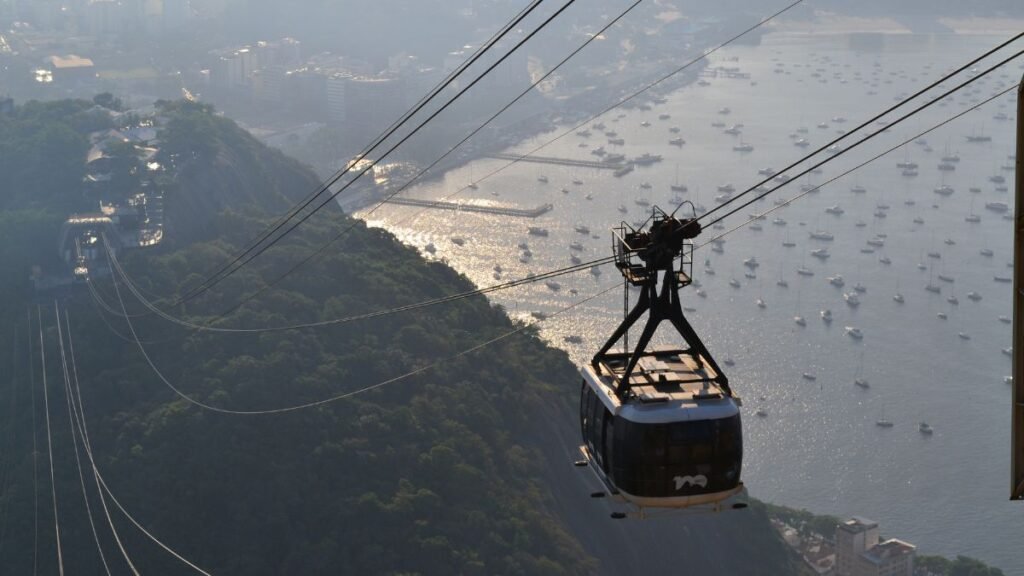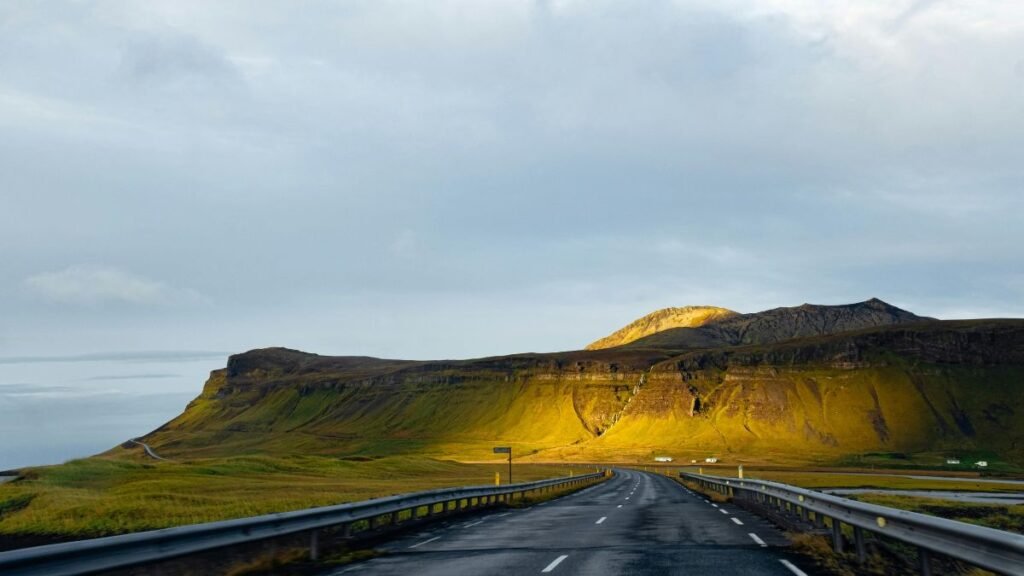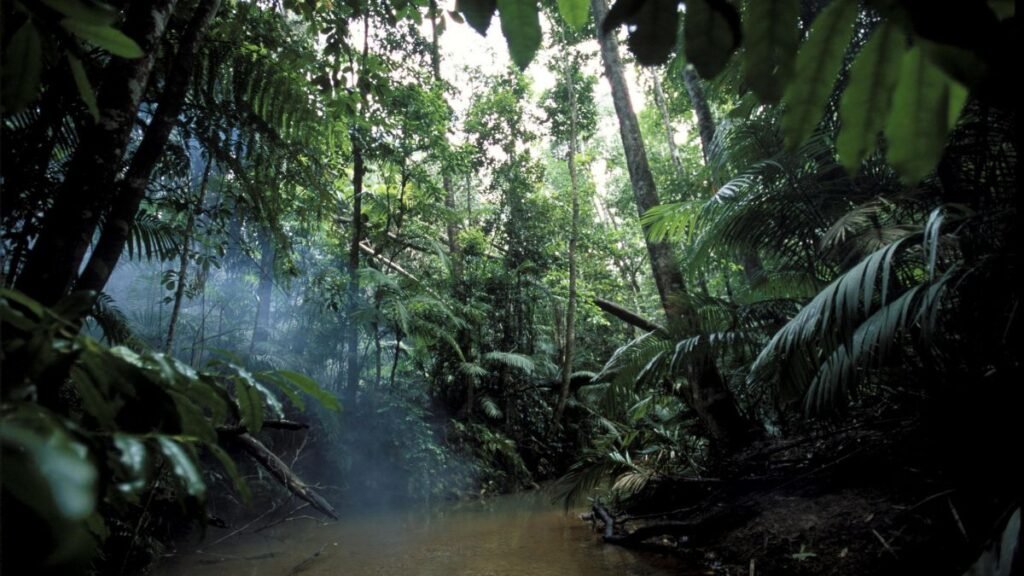Introduction
Did you know that one country holds nearly half of the world’s tropical rainforests and the longest coastline in South America? Spanning over 8.5 million square kilometers, this vast land is larger than the contiguous United States.
Its borders touch ten nations and stretch along the Atlantic Ocean, offering landscapes from golden dunes to emerald jungles. This incredible Brazil Geography showcases a diverse array of ecosystems that are truly breathtaking.

Home to 60% of the Amazon Rainforest, this country leads the world in biodiversity. Its diverse ecosystems range from wetlands to highlands, creating habitats for countless species. Recent projects, like the 2025 elephant sanctuary, highlight its commitment to conservation, showcasing the incredible Brazil Geography that supports such diversity.
Why does this area captivate explorers and scientists alike? The answer lies in its record-breaking natural features and UNESCO sites. Whether you seek adventure or tranquility, this destination delivers unforgettable experiences.
Key Takeaways
- Fifth-largest nation globally, surpassing the contiguous U.S. in size.
- Borders ten countries and boasts a 7,367 km Atlantic coastline.
- Contains 60% of the Amazon Rainforest, a biodiversity hotspot.
- Features diverse climates, from tropical north to temperate south.
- Emerging as a top ecotourism destination with unique conservation efforts.
Introduction to Brazil Geography
From equatorial rainforests to temperate highlands, the landscapes here defy expectations. Spanning four time zones, this country is a tapestry of contrasts, where bustling cities meet untouched wilderness. Its 206 million population thrives in diverse environments, from the Amazon’s heart to Atlantic beaches.
The government divides the land into five macro-regions, each with unique traits. The north is cradled by the Amazon Basin, while the south boasts cooler climates and European-influenced towns. Coastal hubs like Rio de Janeiro contrast with Brasília, the modernist capital located inland.
| Region | Key Features | Population Density |
|---|---|---|
| North | Amazon Rainforest, sparse settlements | 4 people/km² |
| Southeast | Urban centers (São Paulo, Rio) | 87 people/km² |
| South | Vineyards, German/Italian heritage | 48 people/km² |
Agriculture fuels the economy in the Central-West, while industry dominates the Southeast. Yet, environmental challenges loom; deforestation threatens six major biomes, including the Cerrado savanna. Conservation efforts aim to protect these ecosystems, as detailed in this overview of Brazil’s natural wealth.
Beyond land, territorial waters stretch 200 nautical miles, sheltering coral reefs and marine life. Such diversity sets the stage for the natural wonders ahead.
The Amazon Basin: Heart of Brazil’s Natural Splendor
A labyrinth of waterways and emerald canopies defines this ecological powerhouse. Covering 45.7% of the nation, the Amazon basin hosts the planet’s most complex freshwater system, teeming with life and diversity. This vast region not only serves as a crucial habitat for countless species but also plays a vital role in regulating the Earth’s climate.
Its rivers weave through 6,992 km, with 3,615 km flowing through this territory alone, creating a network that supports an intricate web of ecosystems and sustains the livelihoods of many indigenous communities who rely on its resources.
The Mighty Amazon River
Carrying 20% of Earth’s freshwater, the Amazon River dwarfs all rivals, making it not only a vital resource for the surrounding ecosystems but also a crucial lifeline for millions of people who depend on its waters for drinking, agriculture, and transportation.
Seasonal floods create várzeas, fertile wetlands that sustain rare species and act as natural filters, purifying the water and providing rich nutrients that support a diverse array of flora and fauna. Its tributaries split into two types:
| Tributary Type | Water Color | Key Features |
|---|---|---|
| Whitewater | Muddy brown | Acidic, low nutrients, and unique species, including many endemic fish and amphibians that have adapted to these specific conditions. |
| Blackwater | Tea-stained | Acidic, low nutrients, unique species, including many endemic fish and amphibians that have adapted to these specific conditions. |
Recent expeditions have discovered 381 new species here since 2020, highlighting the river’s remarkable biodiversity and underscoring the ongoing need for conservation efforts.
Pink dolphins and giant otters thrive in these rivers, while jaguars patrol their banks, representing just a fraction of the wildlife that calls this extraordinary ecosystem home. The intricate balance of life in and around the Amazon River highlights the importance of preserving this natural wonder for future generations.
The Enigmatic Amazon Rainforest
In this tropical rainforest, 3,000+ species crowd every 2.6 km²—more than anywhere else on the planet, making it a hotspot for biodiversity. This extraordinary variety encompasses not only towering trees and vibrant plants but also numerous insects, birds, and mammals, each playing a vital role in the ecosystem.
Indigenous tribes protect 23% of the Amazon rainforest, using ancient knowledge passed down through generations to combat deforestation and preserve their ancestral lands. Their sustainable practices and deep understanding of the forest’s ecology are vital for maintaining the delicate balance of this rich environment.
Ecotourism offers canopy walks and river cruises, funding conservation initiatives that support both wildlife and local communities. These experiences allow visitors to appreciate the breathtaking beauty of the rainforest while contributing to its preservation.
Scientists estimate that the basin absorbs approximately 2 billion tons of CO₂ annually, thereby slowing climate change and highlighting the rainforest’s crucial role as a carbon sink. This vital function underscores the need for ongoing efforts to protect such an irreplaceable natural resource.
The Pantanal: The World’s Largest Tropical Wetland
Stretching across 230,000 km², this vast wetland rewrites the rules of biodiversity, hosting an astonishing array of flora and fauna. Ten times larger than Florida’s Everglades, the Pantanal spans across three countries: Brazil, Bolivia, and Paraguay, but its heart lies in the west.
Here, water dictates life; 80% vanishes underwater each rainy season, creating Earth’s most dynamic wildlife stage, where species such as capybaras, caimans, and countless bird species thrive in this ever-changing environment.
Wildlife Haven of Yacare Caimans
More than 10 million yacare caimans patrol these waters, the densest population of crocodilians on the planet. These remarkable reptiles play a crucial role in maintaining the ecological balance of the wetlands, preying on fish and small mammals while also serving as prey for larger predators. They share the plains with:
- Jaguars (5 per 100 km²—triple the Amazon’s density), stealthy hunters that navigate the dense underbrush and are known for their powerful jaws capable of crushing turtle shells.
- Hyacinth macaws, their cobalt feathers flashing against green, are not only a stunning sight but also play a vital role in seed dispersal, ensuring the growth of various tree species in the region.
- Giant river otters hunt in synchronized packs, displaying remarkable teamwork as they pursue fish, showcasing the intelligence and social structure of these fascinating mammals.
Seasonal Floodplains and Ecosystems
The land breathes with the seasons, transforming dramatically throughout the year. From April to September, dry plains become cattle grazing grounds, where ranchers manage herds in harmony with the natural environment. When rains return, waterways expand by 300%, creating extensive fish nurseries for 325 species, which allows for a burst of life that attracts numerous migratory birds and other wildlife.
| Season | Water Coverage | Key Wildlife Sightings |
|---|---|---|
| Wet (Oct-Mar) | 80% submerged | Migratory birds, pink river dolphins, and the vibrant life that flourishes in the rich waters. |
| Dry (Apr-Sep) | 20% submerged | Jaguars, capybaras, caiman congregations, and a myriad of other species that thrive in the open plains. |
As a UNESCO Biosphere Reserve, the Pantanal strikes a balance between eco-lodges and working cattle ranches, promoting sustainable tourism that benefits both the environment and local communities.
Visitors float past caimans at sunset or track jaguars at dawn, demonstrating that conservation and tourism can coexist, providing a model for protecting this unique ecosystem while allowing people to experience its wonders.
Guiana Highlands: Brazil’s Towering Wilderness
Rising like ancient sentinels, the Guiana Highlands guard some of Earth’s oldest secrets. This remote mountain range, spanning borders with Venezuela and French Guiana, is a fortress of 2.5-billion-year-old bedrock. Its misty summits and sheer cliffs inspired *Up*’s fictional Paradise Falls.

Pico da Neblina – Brazil’s Rooftop
At 2,995 meters, Pico da Neblina (“Peak of Fog”) pierces the clouds as the nation’s highest mountain. Climbing requires military permits due to its sensitive location near Venezuela, as the area is not only remote but also strategically important.
The peak shelters unique Tepui ecosystems, isolated plateaus hosting carnivorous plants and endemic frogs, many of which are found nowhere else on Earth. These ecosystems have evolved over millions of years, resulting in a rich tapestry of life that thrives in isolation, showcasing nature’s resilience and adaptability.
Ancient Plateaus and Hidden Waterfalls
The highlands’ plateau formations, known as tepuis, are remnants of a Precambrian shield, offering a glimpse into the geological history of our planet. Angel Falls, the world’s tallest waterfall, cascades off a neighboring Venezuelan tepui, creating a breathtaking spectacle that draws adventurers and nature lovers alike.
Brazil’s own waterfalls, such as Cachoeira do El Dorado, remain lesser-known but equally dramatic, often hidden within lush greenery and accessible only through challenging treks that reward explorers with stunning views and a sense of accomplishment.
Indigenous Yanomami communities protect these lands, acting as stewards of the environment and preserving their ancestral knowledge of the region’s flora and fauna. While scientists study rare minerals in the bedrock, they also collaborate with the Yanomami to ensure sustainable practices are maintained.
Research stations monitor climate shifts across elevations, from humid lowlands to chilly summits, gathering invaluable data that highlights the impacts of climate change on these fragile ecosystems. This untamed wilderness demonstrates that altitude significantly enhances biodiversity, serving as a vital refuge for numerous species and a crucial area for conservation efforts.
Brazilian Highlands: Where Mountains Meet the Atlantic
Towering peaks and lush valleys define the dramatic highlands, where nature meets urban life in a stunning juxtaposition. These coastal mountain ranges shape the nation’s climate, culture, and even its cities.
From biodiversity hotspots that serve as critical habitats for numerous species to adrenaline-pumping trails that attract adventure seekers, the highlands offer unmatched diversity that captivates both locals and visitors alike.
The rich tapestry of ecosystems found here is not only vital for wildlife but also plays a crucial role in regulating weather patterns and supporting agricultural practices in surrounding areas.
The Serra do Mar Coastal Range
Stretching an impressive 1,500 km along the coast, the Serra do Mar acts as a natural shield against the encroaching urban landscape. Its steep slopes force moist ocean winds upward, creating rainforests teeming with life and fostering a unique microclimate.
Scientists estimate that around 450 bird species thrive here, more than in all of Europe, making it a paradise for ornithologists and nature enthusiasts alike. This extraordinary avian diversity is complemented by a diverse array of other wildlife, including mammals, reptiles, and numerous plant species, many of which are endemic to the region.
However, urban sprawl from nearby Rio and São Paulo presses against the range, posing significant challenges to conservation efforts. Conservationists work tirelessly to protect endangered species, such as the golden lion tamarin, whose survival depends on the preservation of their natural habitat.
Trails wind through misty peaks, offering hikers panoramic views of the Atlantic, while also serving as vital corridors for wildlife movement. The breathtaking landscapes and rich biodiversity found within the Serra do Mar highlight the urgent need for sustainable development practices that balance urban growth with ecological preservation.
Chapada Diamantina’s Canyons and Caves
Inland, the 1,520-meter-high Chapada Diamantina plateau is home to labyrinthine caves and waterfalls. The 19th-century diamond rush drew migration to this region, leaving ghost towns and mining relics. Today, adventurers rappel down Fumaça Falls, a 380-meter cascade.
| Feature | Serra do Mar | Chapada Diamantina |
|---|---|---|
| Key Attraction | Rainforest biodiversity | Underground caves |
| Adventure Activity | Hiking | Spelunking |
| Threats | Urban expansion | Hydroelectric dams |
Prehistoric art adorns cavern walls, while rare orchids cling to canyon edges. Protected parks ensure species like the maned wolf survive. Whether scaling cliffs or exploring crystal pools, the highlands deliver unforgettable encounters.
Southern Highlands: A Temperate Escape
Winter frost dusts the grasslands here, a rare sight in a nation known for tropical warmth. This region blends European charm with wild beauty, offering a stark contrast to the Amazon’s humidity. The crisp air invigorates the senses, while the landscape is marked by rolling hills adorned with vineyards and orchards, making it a haven for agricultural enthusiasts.
From vine-covered hills to wind-swept plains, the south reveals a quieter, cooler side of the country, where traditional festivals celebrate the rich cultural heritage of the local communities, drawing visitors eager to experience the region’s vibrant traditions and flavors.

The Serra Geral Mountain Range
Ancient lava flows have shaped these mountains, creating cliffs that plunge into valleys and offering breathtaking vistas that attract hikers and nature lovers alike. The unique geological formations provide a glimpse into the Earth’s history, with layers of rock revealing the passage of time.
Fossilized dinosaur tracks near São João do Polêsine offer a glimpse into prehistoric life, captivating the imagination of paleontologists and visitors alike. Today, the range shelters rare species, such as the critically endangered vinaceous-breasted parrot, which thrives in the diverse ecosystems found here, highlighting the importance of conservation efforts in this area.
Wine thrives on Serra Geral’s slopes, thanks to a climate akin to northern Italy, where cool temperatures and rich soils create ideal conditions for viticulture. Over 90% of the nation’s fine wines originate here, making it a vital region for the country’s economy. “The altitude and cool nights lock in acidity, perfect for tannins,” notes a local vintner, emphasizing the meticulous care taken in wine production. Vineyards are often family-owned, passed down through generations, and each bottle tells a story of the land and its people.
Pampas Grasslands of Rio Grande do Sul
Spanning 700,000 km² across three nations, the Pampas are a vast expanse of golden grasslands, characterized by vast open spaces and a rich biodiversity that supports a diverse array of wildlife.
Gaúchos, South America’s cowboys, herd cattle here using techniques unchanged for 200 years, a testament to their enduring traditions and deep connection to the land. Their churrasco barbecues, rooted in this tradition, are now world-famous, drawing food enthusiasts from around the globe to experience the unique flavors of the region.
| Feature | Serra Geral | Pampas |
|---|---|---|
| Climate | Cool, alpine | Temperate, windy |
| Key Industry | Viticulture | Livestock |
| Threats | Soil erosion | Invasive pines |
Wind farms now dot the plains, harnessing breezes that once fueled tallgrass waves, providing sustainable energy while preserving the natural landscape. Conservationists balance agriculture with ecotourism, protecting endemic birds like the greater rhea, which roams freely in these grasslands.
Meanwhile, German and Italian immigrants left a legacy of polka music and vine-covered cottages, making this region a cultural crossroads, where diverse traditions merge to create a rich tapestry of life.
Brazil’s Coastal Marvels: Beaches, Dunes, and Coral Reefs
Golden shores and turquoise waters define this coastal paradise, where nature’s artistry meets conservation triumphs. The Atlantic Ocean carves a 7,367-km coastline dotted with UNESCO sites and ecological treasures. Luxury eco-resorts nestle beside protected reserves, striking a balance between tourism and fragile ecosystems.
Fernando de Noronha’s Pristine Archipelago
This 21-island chain sets the gold standard for marine preservation, recognized globally for its commitment to protecting biodiversity. Its volcanic peaks rise dramatically from the crystal-clear waters, which shelter an impressive array of 230 fish species and endangered hawksbill turtles, a symbol of the archipelago’s ecological significance.
Strict visitor limits (max 460 daily) protect its coral reefs, where spinner dolphins perform acrobatics at dawn, delighting visitors with their playful antics. The archipelago is also a sanctuary for various seabird species, making it a vital habitat for avian life.
- Sea turtle nests are monitored via AI drones to ensure hatchling survival rates are maximized.
- Solar-powered desalination plants are reducing plastic waste and promoting sustainable water use.
- Kitesurfing zones are kept 500m from seabird breeding areas to minimize disturbances during critical nesting periods.
Lençóis Maranhenses’ Otherworldly Sand Dunes
Rain transforms this 1,550km² dune field into a mirror maze, creating a stunning visual spectacle that attracts photographers and nature lovers alike. From June to September, freshwater lagoons form between sand dunes, creating surreal swimming pools that reflect the sky and provide a unique habitat for local wildlife.
The park’s “no footprints” policy ensures dunes shift undisturbed by tourism, allowing the natural landscape to evolve without human interference.
| Season | Landscape | Activities |
|---|---|---|
| Dry (Oct-May) | Wind-sculpted dunes that shift and change with the seasons | Dune buggy tours that provide thrilling exploration of the vast landscapes |
| Wet (Jun-Sep) | Turquoise lagoons teeming with life | Swimming, photography, and guided eco-tours |
Abrolhos Marine Park, located 950km south, offers a contrasting underwater spectacle. Its coral reefs host 18 endemic species, including brain corals resistant to bleaching, showcasing the resilience of marine ecosystems. Lighthouse ruins along the coast whisper tales of 16th-century shipwrecks, adding a historical dimension to the natural beauty.
Coastal erosion threatens 60% of this shoreline, prompting innovative defenses, such as artificial reefs, that help protect marine life and stabilize the coastline. From Noronha’s luxury retreats to Lençóis’ rustic camps, tourism now fuels conservation—a model for protecting paradise.
To truly appreciate Brazil’s diverse geography — from the vast Amazon rainforest to the sweeping coastlines and highland plateaus — it’s important to understand the country’s rich historical background. Brazil’s natural landscapes have not only shaped its culture and economy, but also played a vital role in its colonial past, indigenous heritage, and territorial development. Learn more about this fascinating connection in our complete guide to Brazil History
Conclusion: Why Brazil’s Geography Is Unmatched
Few places in the world combine ecological wonders with economic vitality like this nation. It’s 59% forest cover shelters biodiversity, while eight drainage basins fuel agriculture and petroleum reserves. The fifth-largest arable land feeds coffee exports and global markets.
Climate diversity, ranging from tropical wetlands to temperate highlands, supports a wide range of unique ecosystems. Yet challenges like deforestation test conservation wins, such as jaguar recovery programs. Ecotourism, projected to grow at a 12% annual rate, now accounts for 40% of the funding for protected areas.
Cultural ties to the land run deep. Indigenous knowledge guides migration routes for species, while cities innovate green policies. This region demonstrates that nature and progress can coexist harmoniously.
For travelers, responsible tourism ensures that these wonders endure. Explore with care, and witness a country where geography shapes destiny.
FAQ
What makes the Amazon Basin unique in South America?
The Amazon Basin spans multiple countries and hosts the world’s largest tropical rainforest. Its vast river system and biodiversity make it a global ecological treasure.
What makes the Pantanal a renowned wildlife paradise?
The Pantanal’s seasonal floods create nutrient-rich wetlands, attracting species like jaguars, capybaras, and over 650 bird species, making it a top ecotourism destination.
Where is Brazil’s highest peak located?
Pico da Neblina, standing at 9,823 feet, rises in the Guiana Highlands near Venezuela. Its mist-covered summit is a challenge for avid hikers.
What coastal features define Brazil’s Atlantic shoreline?
From Fernando de Noronha’s coral reefs to Lençóis Maranhenses’ shifting dunes, the coast blends vibrant marine life with surreal landscapes.
How do the Brazilian Highlands influence regional climates?
These highlands create microclimates, with the Serra do Mar range trapping moisture from the ocean, fueling lush forests and cascading waterfalls.
Are there temperate regions in this tropical country?
Yes! The Southern Highlands, including the Pampas grasslands, offer cooler climates, rolling hills, and vineyards akin to European landscapes.
What role does the Amazon River play in Brazil’s ecosystem?
The river supports 40% of South America’s freshwater species and serves as a lifeline for indigenous communities and the health of the rainforest.
Can visitors explore the Guiana Highlands’ ancient terrain?
Absolutely. Remote plateaus, such as Mount Roraima, feature prehistoric rock formations and waterfalls, accessible via guided expeditions.




